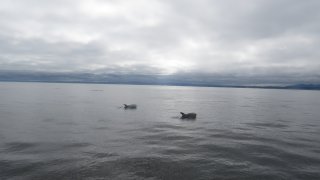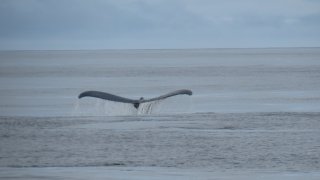Celebrating 50 Years of Protecting the Ocean
The whale-watching ship’s engine rumbles in the beating heart of California’s Monterey Bay. The Pacific Ocean is a dizzying blue and as smooth as glass against the horizon. A humpback whale breaks the calm, slapping its forked tale with an echoing splash. Seconds later, two Risso’s dolphins burst into the air, their gray and white-splotched bodies in symmetry.
I feel connected to these charismatic animals and marvel at their ability to survive. Humpback whales swim up to 5,000 miles from tropical to colder waters in search of food. Using vocalizations to communicate, male humpback whales share songs with fellow species they meet on long-distance journeys across the Pacific Ocean. During their travels, these marine animals may face plastic pollution, impacts of climate change, and other threats. Their future survival can hinge on environmental laws that protect the ocean.
Safeguarding Coastal Resources
My passion for ocean conservation makes me proud to work for the U.S. Environmental Protection Agency, which issues permits under the Marine Protection, Research and Sanctuaries Act. This October 2022, EPA celebrates the 50th anniversary of this law, which prohibits the dumping of certain types of waste into the ocean and established one of the first international agreements to protect marine environments from human activities. It guides the work of EPA Pacific Southwest Region’s oceanographer Allan Ota, whose passion for the ocean began, like mine, when he was a child. “I grew up watching Jacques Cousteau exploring the sea on TV. It captivated me,” Ota states.
Ota and his team oversee and monitor the disposal of non-toxic sediments like sand and dirt at 12 designated sites offshore in California, Hawaii and Guam. Sediments build up in urban estuaries where ports, marinas, and channels are located. The team may dispose of clean sediments in the ocean, but contaminated materials must go to a disposal facility or an upland site. The goal of this program is to ensure shipping vessels can safely move in and out of ports, while also protecting the marine environment.
Promoting Safe Navigation While Protecting Wildlife
Dredging in harbors and estuaries can affect wildlife. Fish, sea turtles, and other animals use these areas as migratory corridors. Harbors and estuaries support eel grass beds and other habitats that provide nurseries for juvenile fish. Dredging near sensitive areas requires that EPA collaborate and consult with the National Oceanic Atmospheric Administration and the U.S. Fish and Wildlife Service. When dredging, the team uses silk curtains to reduce murkiness, which protects marine habitats. Once excavated, the dredge bucket drops sediments into a screen on the barge, which separates larger materials from finer mud and sand. Ota notes “often trash, even things like refrigerators, are sadly a common occurrence in urban estuaries and harbors. Removing this trash helps keep the marine environment cleaner.”
Providing Access to Nature
Ota is excited about a project to reuse clean sediment to restore wetlands and replenish beaches. Sea level rise driven by climate change is inundating wetlands with salt water and eroding beaches. As coastlines recede and beaches become narrower or even disappear, local communities are vulnerable to flooding and other severe weather events. These events can destroy property, infrastructure and even cause deaths.

Development has destroyed large swaths of these habitats that once served as buffers during storms. San Francisco and San Diego bays have lost 90 percent of their historic wetlands. Federal, state and local agencies continue to work together to restore these areas, particularly in our most vulnerable communities.
Connecting communities to our natural wonders resonates with me. I think of the vulnerable wildlife in Monterey Bay and the fragile salt marshes across the country. As a former National Park Service ranger, I led 25 eighth graders on a beach and marsh walk in Chincoteague, Virginia’s Assateague Island National Seashore. Many lived within an hour’s drive of the national seashore, famous for its wild ponies, but their families lacked the financial resources to visit. I still remember how the wildlife enraptured the students.

“What’s that?” they exclaimed, pointing to a translucent ghost crab that skittered across the sand and jumped into a hole. A red-winged blackbird chirped, flashing its bright red patch, a striking contrast against its black plumage. “I never knew there were so many cool animals here,” a student said. When they learned marshes served as grocery stores, recycling centers and nurseries for wildlife, they wanted to return. “I’m taking my family here,” I overheard another student announce. After the program, the students ran on the beach with total abandon and pure joy.
I will never forget those students in Virginia or watching the humpback whale and Risso’s dolphins in Monterey Bay. Giving communities access to beaches and wetlands helps connect them to nature. Experiencing these wild places could change their lives—it has mine.

About the Author
Hilary Clark
Writer-Editor
Region 9, EPA’s Pacific Southwest Region
Hilary Clark is a writer-editor for EPA’s Pacific Southwest Region. She has also served as a community involvement coordinator doing public outreach for Superfund sites. Before working for EPA, Hilary worked as a National Park Service ranger at various sites across the country. Her experience has made her passionate about protecting wild places and wildlife.
Editor’s Note: The views expressed here are intended to explain EPA policy. They do not change anyone’s rights or obligations. You may share this article. However, please do not change the title or the content, or remove EPA’s identity as the author. If you do make substantive changes, please do not attribute the edited title or content to EPA or the author.
EPA’s official web site is www.epa.gov. Some links on this page may redirect users from the EPA website to specific content on a non-EPA, third-party site. In doing so, EPA is directing you only to the specific content referenced at the time of publication, not to any other content that may appear on the same webpage or elsewhere on the third-party site, or be added at a later date.
EPA is providing this link for informational purposes only. EPA cannot attest to the accuracy of non-EPA information provided by any third-party sites or any other linked site. EPA does not endorse any non-government websites, companies, internet applications or any policies or information expressed therein.


